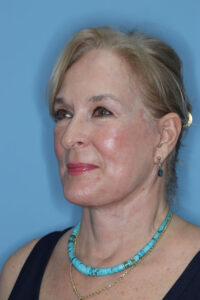Un Maestro del Arte y la Precisión en la Cirugía Plástica Facial
Por: Nancy Esteves
Guiado por una profunda pasión por la ciencia y el arte, el distinguido Dr. Karan Chopra considera la cirugía plástica como un delicado equilibrio entre precisión y creatividad. Reconocido experto en estética facial, el Dr. Chopra asegura que su compromiso radica en obtener resultados “naturales” que armonicen y realcen la belleza, respetando siempre la individualidad y autenticidad de cada paciente.

 Ubicado en el corazón de Coral Gables, el Dr. Chopra combina tecnología avanzada con un enfoque altamente personalizado. Emplea imágenes 3D y 2D de última generación para colaborar estrechamente con sus pacientes, planificando cada procedimiento con meticulosidad, asegurando comunicación clara y generando confianza mediante resultados visualizados.
Ubicado en el corazón de Coral Gables, el Dr. Chopra combina tecnología avanzada con un enfoque altamente personalizado. Emplea imágenes 3D y 2D de última generación para colaborar estrechamente con sus pacientes, planificando cada procedimiento con meticulosidad, asegurando comunicación clara y generando confianza mediante resultados visualizados.
Especialista en procedimientos de lifting facial y de cuello, el Dr. Chopra describe su labor como un “arte de precisión milimétrica,” destacando la habilidad y atención al detalle necesarias en estas transformaciones. Sus técnicas no solo rejuvenecen la apariencia, sino que también elevan la autoestima de sus pacientes.
El Dr. Chopra, cirujano plástico certificado por la junta médica, perfeccionó su formación en el prestigioso Hospital Johns Hopkins, reconocido por U.S. News & World Report como el mejor hospital del país durante 21 años consecutivos.
Innovador en su campo, el Dr. Chopra continúa desarrollando técnicas revolucionarias, como su dispositivo patentado Liposhot, que restaura el volumen facial y mejora la calidad de la piel mediante el poder regenerativo de las células madre.
¿Qué lo inspiró a seguir una carrera en cirugía plástica?
Siempre me atrajo la profesión debido a mi amor por la ciencia y mi habilidad con las matemáticas. Sin embargo, descubrí varias especialidades médicas una vez que ingresé a la facultad de medicina y comencé a aprender bajo el modelo de mentoría. Me cautivaron de inmediato los aspectos creativos, artísticos e innovadores de la cirugía plástica. Dentro del campo de la medicina, esta especialidad destacó no solo por su enfoque estético, sino también por la posibilidad de explorar áreas como la cirugía reconstructiva y la medicina regenerativa.
Lo que más me gusta de la cirugía plástica es la satisfacción de devolverle a un paciente su sensación de plenitud. Ya sea una reconstrucción mamaria tras un diagnóstico de cáncer o resolver problemas cosméticos hereditarios como la flacidez del cuello o párpados caídos, los resultados transformadores son increíblemente gratificantes. Además, la mentoría jugó un papel crucial en mi camino. El Dr. Devinder Singh, de la Universidad de Maryland, fue clave en guiarme hacia esta especialidad, permitiéndome aprender y desarrollar experiencia en procedimientos estéticos y reconstructivos.
¿Siempre tuvo pasión por la cirugía facial?
Sí, la anatomía compleja y el nivel de detalle requerido en la cirugía facial siempre han resonado conmigo. Amo el desafío de entender la anatomía facial a profundidad y la precisión técnica que implica. Aunque las cirugías de cuerpo y pecho son gratificantes, los procedimientos faciales como lifting de párpados, faciales, de cuello y labios presentan un “juego de precisión milimétrica” que encuentro particularmente emocionante.El mejor momento para mí es cuando los pacientes ven sus resultados tras una o dos semanas de leves hematomas e hinchazón. Esa transformación y la confianza renovada hacen que todo valga la pena.
¿Tiene una filosofía específica en cuanto a la estética facial?
Mi filosofía se resume en una palabra: “naturalidad.” La cirugía plástica a menudo tiene una mala reputación por procedimientos exagerados o mal realizados. Sin embargo, el rejuvenecimiento facial ejecutado con maestría ofrece resultados sutiles y sorprendentes. Cuando la cirugía se realiza con habilidad y visión artística, los resultados realzan la belleza natural de la persona.
Los principios de equilibrio y proporción son mi guía. Algunos procedimientos buscan rejuvenecer, mientras que otros crean armonía entre las características faciales. Lograr resultados naturales mientras cumplo con las expectativas de mis pacientes requiere un análisis detallado de su anatomía y tiempo para entender sus objetivos. Utilizamos tecnología avanzada de imágenes 3D y 2D para visualizar características actuales y diseñar un plan quirúrgico en colaboración, asegurando que el paciente alcance su apariencia deseada sin perder su esencia.
¿Qué papel tiene un cirujano plástico en la autoestima y la positividad corporal?
No cabe duda de que la cirugía plástica puede fomentar la autoestima y la positividad corporal. Una vez que se supera el estigma, se comprende su potencial para ayudar a las personas a sentirse más como ellas mismas. Aunque los cambios en el estilo de vida como dieta y ejercicio mejoran ciertos aspectos, algunos problemas son genéticos y solo pueden abordarse quirúrgicamente.
Con frecuencia atiendo a pacientes en sus 60 que han llevado vidas vibrantes pero sienten que su apariencia facial ya no refleja su energía. Los procedimientos de rejuvenecimiento facial permiten que “los 60 sean los nuevos 40,” ayudándoles a recuperar confianza.
¿Qué papel juega la tecnología en la cirugía plástica?
La tecnología es crucial para mejorar los resultados y la experiencia del paciente. Uso software avanzado como el sistema Vectra 3D para analizar resultados y demostrar expectativas realistas. Esto promueve transparencia y colaboración.
También soy inventor del dispositivo Liposhot, que revoluciona el injerto de grasa en cirugía facial. Este sistema todo-en-uno permite extraer, procesar y reinyectar grasa, restaurando volumen y mejorando la calidad de la piel mediante células madre. Ofrece un aspecto más natural y duradero que los rellenos.
¿Ha tenido que rechazar pacientes?
Sí, hay ocasiones en las que no procedemos con ciertos pacientes, usualmente por expectativas poco realistas o preocupaciones tecnológicas. También evaluamos a los pacientes durante las consultas para detectar señales de alerta. Una relación sólida entre cirujano y paciente es esencial para navegar los desafíos durante el proceso de curación.
¿Qué tendencias ve en la cirugía plástica para los próximos 10 años?
En los próximos cinco años, preveo un mayor énfasis en resultados naturales y terapias regenerativas como exosomas, que mejoran el cuidado de la piel y la recuperación postoperatoria. También hay una creciente preferencia por procedimientos menos invasivos y un interés en rejuvenecimientos faciales tempranos.
¿Tiene proyectos personales?
Una innovación emocionante es realizar liftings profundos de cara y cuello sin anestesia tradicional, reduciendo tiempos de recuperación.
¿Cuándo esta fuera del quirófano, que más lo apasiona?
Valoro el tiempo con mis hijos, Arjun y Niam, y mi esposa, la Dra. Jasleen Chopra, quien es profesora en la Universidad de Miami. Ella es el secreto detrás de mi éxito, ayudándome a equilibrar mi carrera y mi familia.
A Master of Art and Precision in Facial Plastic Surgery
By: Nancy Esteves
Driven by a profound passion for both science and artistry, the distinguished Dr. Karan Chopra views plastic surgery as a delicate balance between precision and creativity. A celebrated expert in facial aesthetics, Dr. Chopra says he is committed to achieving “natural” results—enhancing harmony and proportion while honoring the individuality and authenticity of each patient.
Located in the heart of Coral Gables, Dr. Karan Chopra blends advanced technology with a deeply personalized approach to plastic surgery. Using state-of-the-art 3D and 2D imaging, he collaborates closely with each patient to meticulously plan procedures, ensuring clear communication and building trust through visualized outcomes.
An expert in facelift and neck lift procedures, Dr. Chopra refers to his work as a “high-stakes game of millimeters,” underscoring the precision and artistry involved in these transformative surgeries. His techniques not only rejuvenate appearances but elevate self-esteem.
Dr. Chopra, a Board-Certified Plastic Surgeon, has refined his craft at the renowned Johns Hopkins Hospital, recognized by U.S. News & World Report as the nation’s top hospital for 21 consecutive years.
A visionary in the field, Dr. Chopra continues to innovate with groundbreaking techniques like his patented Liposhot device, which restores facial volume and enhances skin quality using the regenerative power of stem cells.
What inspired you to pursue a career in plastic surgery?
I was always drawn to the profession because of my love for science and my aptitude for math. However, I discovered various medical specialties once I entered medical school and began learning through the mentorship model. I was immediately captivated by plastic surgery’s creative, artistic, and innovative aspects. Within the broader field of medicine, plastic surgery stood out. Not only does it encompass aesthetic medicine, but it also offers opportunities to explore research in reconstructive surgery and regenerative medicine.
What I love most about plastic surgery is the immense satisfaction of restoring a patient’s sense of wholeness. Whether performing breast reconstruction after a cancer diagnosis or addressing inherited cosmetic concerns like neck fullness or droopy eyelids, the transformative results are incredibly rewarding. Beyond that, mentorship played a significant role in my journey. Dr. Devinder Singh at the University of Maryland was instrumental in guiding me toward this field. Under his mentorship, I was exposed to various cosmetic and reconstructive procedures, which fostered my growth and expertise in facelift and neck lift surgeries.
Did you always have a passion for facial surgery?
Yes, the intricate anatomy and the attention to detail required in facial surgery resonate deeply with me. I love the challenge of understanding facial anatomy at a profound level and the meticulous technique it demands. While breast and body surgeries bring their unique rewards, facial surgeries like eyelid lifts, facelifts, neck lifts, and lip lifts involve a “high-stakes game of millimeters,” which I find particularly gratifying.
The best part of facial surgery for me is witnessing a patient’s reactions when they see their results after just a week or two of mild bruising and swelling. That moment of transformation and renewed confidence makes the process so fulfilling.
Do you have a specific philosophy when it comes to facial aesthetics?
My philosophy can be summed up in one word: “natural.” Plastic surgery often has a bad reputation due to overdone or poorly performed procedures. However, masterfully executed facial rejuvenation and beautification produce subtle and stunning results. When surgery is performed with skill and an artistic eye, the outcomes are seamless and enhance a person’s natural beauty.
Principles of balance and proportion guide me. Some procedures aim to make patients look more youthful, rested, and rejuvenated, while others help create harmony and balance between facial features. Achieving natural results while meeting my patients’ expectations requires carefully reviewing their anatomy and spending ample time understanding their goals. We use advanced 3D and 2D imaging technology during consultations to visualize their current features and collaboratively design a surgical plan. This approach ensures patients achieve their desired look without losing their sense of self.
What is a plastic surgeon’s role in self-esteem and body positivity?
There’s no doubt that plastic surgery can promote self-esteem and foster body positivity. Once you move past the stigma often associated with it, you realize its potential to help people feel more like themselves. While lifestyle changes like diet and exercise can improve certain aspects of appearance, some issues are genetic and can only be addressed surgically.
I often see patients in their 60s who have led vibrant lives but feel their facial appearance no longer reflects their energy and zest for life. Targeted facial rejuvenation procedures can bridge this gap, allowing “60 to be the new 40.”
What role does technology play in plastic surgery?
Technology plays a crucial role in enhancing outcomes and patient experiences. I use cutting-edge 3D imaging software like the Vectra 3D system to study my surgical outcomes and demonstrate realistic patient expectations. This technology clearly visualizes potential results, fostering transparency and collaboration.
Additionally, I am the inventor and patent holder of a device called Liposhot, which revolutionizes fat grafting in facial plastic surgery. This all-in-one solution allows for harvesting, processing, and reinjecting fat. Fat grafting not only restores volume but also enhances skin quality through the delivery of stem cells. It offers a more natural look and feel compared to fillers, with longer-lasting results.
Have you ever had to turn down a patient?
Yes, there are instances where we decline to proceed with certain patients. It is usually due to an inability to meet their expectations, which sometimes means they are unrealistic. Sometimes, the current state of plastic surgery technology isn’t advanced enough to address specific concerns.
We also assess patients during consultations for any red flags. While patients interview surgeons, we evaluate whether they are a good fit for our practice. A strong surgeon-patient relationship is vital, especially in navigating any challenges during the healing process. Mutual trust and respect are the cornerstones of a successful journey.
What trends do you see for plastic surgery over the next 10 years?
The field of plastic surgery is evolving rapidly, and predicting its future is both exciting and challenging. Over the next five years, I anticipate an increasing emphasis on natural results and advancements in regenerative therapies, such as exosomes, which enhance skincare and postoperative healing.
We’re already witnessing a shift toward minimally invasive procedures, such as fat grafting for breast augmentation, which offers a natural alternative to silicone implants. There is also a notable decline in the demand for buttock augmentation procedures like the Brazilian Butt Lift (BBL), with many patients now requesting reversals.
One trend I find particularly exciting is the growing popularity of earlier facial rejuvenation procedures. Deep plane facelifts and neck lifts are becoming the “next mommy makeover” as younger patients opt for preventative enhancements in their 30s and 40s rather than waiting until later.
Do you have any personal projects?
One of our most exciting developments is performing deep plane face and neck lifts without traditional anesthesia. These procedures can now be done without general or IV sedation, reducing recovery time and eliminating the risks associated with anesthesia.
What are your other passions when you’re not in the operating room?
Outside of work, I cherish spending time with my two sons, Arjun and Niam, and my wife, Dr. Jasleen Chopra, an assistant professor of breast imaging at the University of Miami. She is the secret to my success, enabling me to dedicate myself to my patients while maintaining balance with our growing family.



 Contact Us
Contact Us